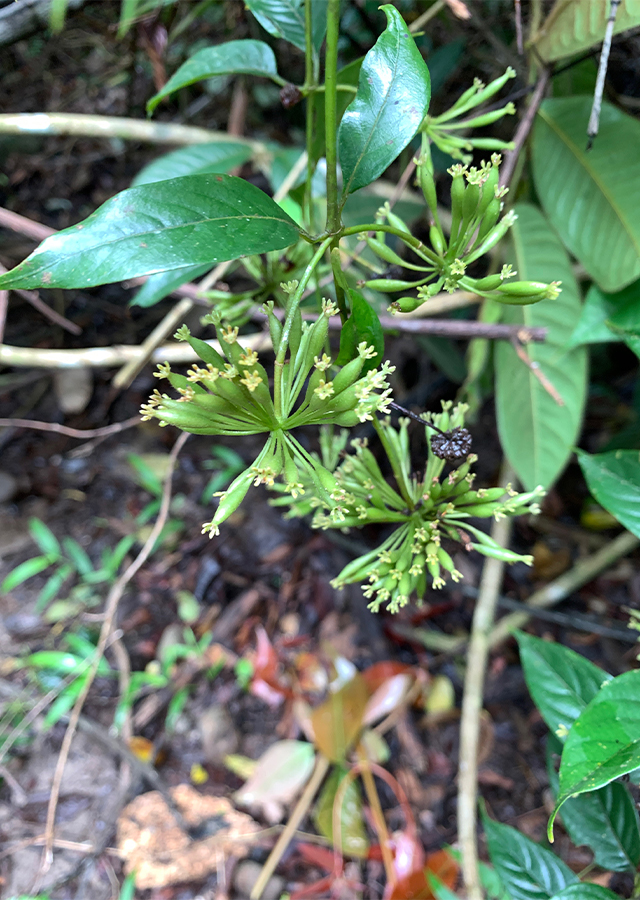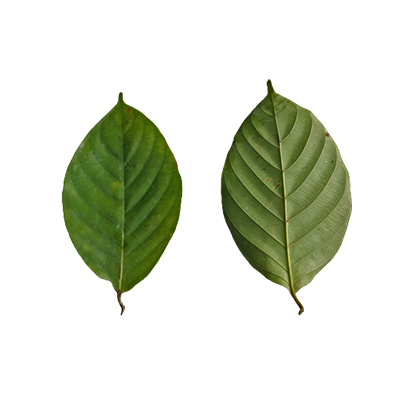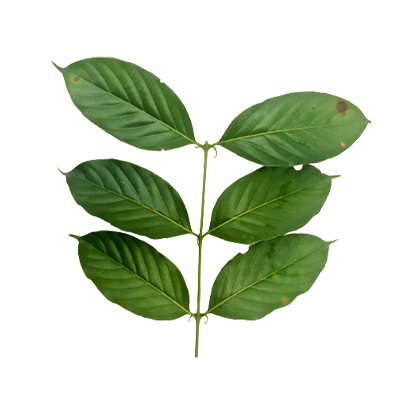Cat's Claw
Uncaria rhynchophylla (Miq.) Miq.
Rubiaceae
Location in our garden
Green House



Synonym
Nauclea rhynchophylla Miq.
Ourouparia rhynchophylla (Miq.) Matsum.
Habitus
Climbers. A climber perennial plant, hermaphrodite, grow up to 8 m
Part Used
Leaves
Bark
Twigs
Growing Requirements
Full Sunshine
Need Shade
Habitat
Forest
Overview
Cat's claw is a traditional Chinese herb, the use of which can be traced back more than a thousand years. A more comprehensive description of the plant and function can be found in the ‘Origins of the Materia Medica’ (Ben Cao Yuan Shi), compiled in the 17th century in China. Its native range is S. China to Vietnam, Taiwan, S. Central & S. Japan.
Vernacular Names
Cakar elang (Indonesian), Gou teng (Chinese).
Agroecology
This plant is suitable for light (sandy), medium (loamy) and heavy (clay) soils. With the pH of acid, neutral and basic (alkaline) soils. It can grow in semi-shade (light woodland) or no shade. It prefers moist soil.
Morphology
- Roots - taproot with a lot of lateral roots.
- Stem - small, woody, old stem with brown color, there are hooks as vegetative lateral branches.
- Leaves - opposite, simple, domatia usually present in the axils of the lateral veins, tertiary veins usually impressed; petiole present, stipules interpetiolar, entire or bifid, inside with colleters at the base or over the whole surface.
- Flowers - bisexual, 5-merous, (sub)sessile or pedicellate on the receptacle, pedicels free or fused into groups, sometime accrescent, with or without interfloral bracteoles, receptacle sparsely to densely hairy; calyx tube short, often bottle-shaped, lobes variable in shape, glabrous to hairy.
- Fruit - dry capsule, 2-celled, exocarp thick, splitting loculicidally but long remaining intact below the calyx remnants, endocarp thick, horny, splitting septicidally and then slightly loculicidally from apex to base.
- Seed - small, centre reticulate, long winged at both ends, lower wing deeply bifid.
Cultivation
Propagated through seeds and stem cutting.
Chemical Constituents
Flavonoids, terpenoids, rhynchophylline, α-tokoferol, isorhynchophylline, corynoxeine, isocorynoxeine, hirsuteine (120-60), hirsu-tine (120-7), corynantheine (120-8), dihydrocory-nantheine (120-9), fenilpropanoid, ursolic acid lactone, quercetine, epicatechin, oxindole.
Traditional Medicinal Uses
- U. rhynchophylla extract showed to be neuroprotective, anticonvulsive, and antipsychotic, and improving cognition in patients with dementia.
- Its pharmacological effects, such as sedative, inhibit platelet aggregation and thrombosis, relieve dyspnea, improve digestion are also reported.
- It has highly effective as antihypertensive, and effective as antiarrhythmic, antispasmodic, antidiarrheal, carminitive, antiemetic, and febrifuge.
- U. rhynchophylla, used alone or in combination with other herbs, is one classical formula with U. rhynchophylla and Gastrodia elata as the key ingredients (Tian Ma Gou Teng Yin), is routinely used in clinical practice for relieving dizziness, headache and insomnia due to hypertension, cerebrovascular diseases, epileptic and auditory vertigo.
- The curved thorns decoction is used in the treatment of infantile convulsions, headaches, dizziness, hypertension and apoplexy.
Part Used
Reference Sources
- Chinese Herbal Medicine. (No date). Gou Teng – Uncaria stem and thorns – Uncaria rhynchophylla, U. sinensis, and related species – “Hook Vine”. http://chineseherbinfo.com/gou-teng-uncaria-stem-and-thorns-uncaria-rhynchophylla-u-sinensis-and-related-species-hook-vine/. 23-02-2021.
- Herbpathy. (No date). Uncaria rhynchophylla Herb Uses, Benefits, Cues, Side Effects, Nutrients. https://herbpathy.com/Uses-and-Benefits-of-Uncaria-Rhynchophylla-Cid5203. 23-02-2021.
- Lymeguide. (No date). UNCARIA RHYNCHOPHYLLA (GOU TENG). https://lymeguide.info/uncaria-rhynchophylla-gou-teng/. 23-02-2021.
- MD Health Online. (No date). Uncaria Rhynchophylla. https://mdhealthonline.com/uncaria-rhynchophylla/. 23-02-2021.
- PFAF. (No date). Uncaria rhynchophylla. https://pfaf.org/user/Plant.aspx?LatinName=Uncaria+rhynchophylla. 23--02-2021.
- PROSEA. 2002. PROSEA Record display. https://prota4u.org/prosea/view.aspx?id=1360 23-02-2021.


